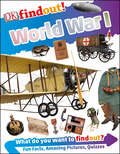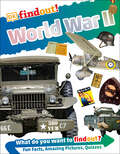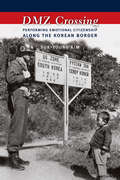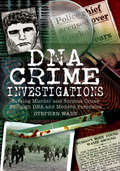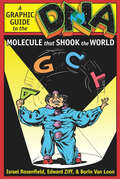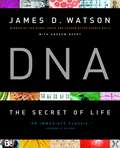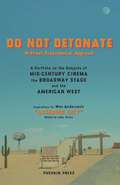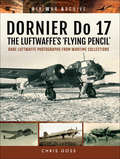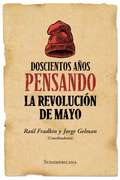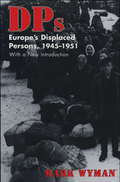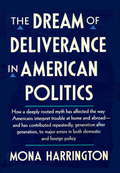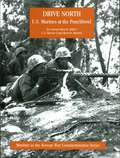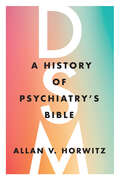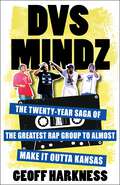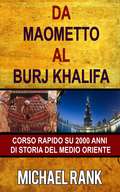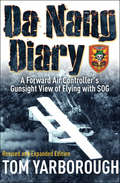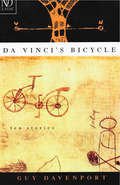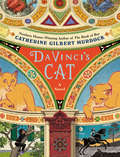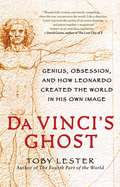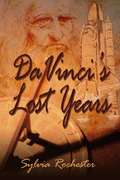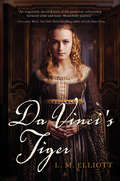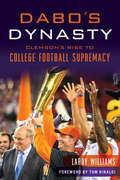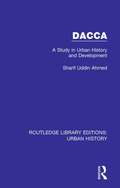- Table View
- List View
DKfindout! World War I (DK findout!)
by Brian WilliamsThis photo-filled book for kids ages 6–9 is the ultimate guide to the key facts, figures, and players of World War I. Educating young readers through a combination of close-up images, trivia facts, quiz questions, and fascinating tidbits, it&’s the perfect book for any kid who wants to learn more about military history.How did World War I start? Which statue was damaged in the lead-up to the United States entering the war? Which countries had the biggest army and the best weapons? Find out the answers to these questions and more in DKfindout! World War I, which features photographs and illustrations of war machines, battlefields, and world leaders from throughout the span of this widespread conflict. Readers will learn about both sides of the war—the Central Powers and the Allied Powers—as well as each country&’s motivation for entering the conflict. Sections on military strategy and life during the war delve deeper into central subtopics, and detail how advancements in military technology like tanks and chemical weapons changed the course of battles all across the European continent.Vetted by educational consultants, the DKfindout! series drives kids ages 6–9 to become experts on more than 30 of their favorite STEM- and history-related subjects, whether Vikings, volcanoes, or robots. This series covers the subjects that kids really want to learn about—ones that have a direct impact on the world around them, like climate change, space exploration, and rapidly evolving technology—making learning fun through amazing images, stimulating quizzes, and cutting-edge information. The DKfindout! series is one that kids will want to turn to again and again.
DKfindout! World War II (DK findout!)
by Brian Williams2020 marks the 75th anniversary of the end of World War II, and this photo-filled book is perfect for teaching kids ages 6–9 about the conflict and its lasting impact. Entertaining and educating young readers through a combination of close-up images, trivia facts, quiz questions, and fascinating tidbits, it&’s the ultimate guide for any kid who is hungry to learn more about military history.When did World War II begin? How were people protected during an air raid? How did the Allies crack the enemy&’s secret code? Find out the answers to these questions and more in DKfindout! World War II, which features photographs and illustrations of war machines, battlefields, and world leaders from throughout the span of this widespread conflict. Readers will learn about the rise of Nazi Germany, the bombing of Pearl Harbor, and life during the war. From the horrors of the Holocaust to the Allies&’ victory against the Germans on D-Day, DKfindout! World War II will provide kids with plenty of important details to pore over.Vetted by educational consultants, the DKfindout! series drives kids ages 6–9 to become experts on more than 30 of their favorite STEM- and history-related subjects, whether Vikings, volcanoes, or robots. This series covers the subjects that kids really want to learn about—ones that have a direct impact on the world around them, like climate change, space exploration, and rapidly evolving technology—making learning fun through amazing images, stimulating quizzes, and cutting-edge information. The DKfindout! series is one that kids will want to turn to again and again.
DMZ Crossing
by Suk-Young KimThe Korean demilitarized zone might be among the most heavily guarded places on earth, but it also provides passage for thousands of defectors, spies, political emissaries, war prisoners, activists, tourists, and others testing the limits of Korean division. This book focuses on a diverse selection of inter-Korean border crossers and the citizenship they acquire based on emotional affiliation rather than constitutional delineation. Using their physical bodies and emotions as optimal frontiers, these individuals resist the state's right to draw geopolitical borders and define their national identity. Drawing on sources that range from North Korean documentary films, museum exhibitions, and theater productions to protester perspectives and interviews with South Korean officials and activists, this volume recasts the history of Korean division and draws a much more nuanced portrait of the region's Cold War legacies. The book ultimately helps readers conceive of the DMZ as a dynamic summation of personalized experiences rather than as a fixed site of historical significance.
DMZ Crossing: Performing Emotional Citizenship Along the Korean Border
by Suk-Young KimThe Korean demilitarized zone might be among the most heavily guarded places on earth, but it also provides passage for thousands of defectors, spies, political emissaries, war prisoners, activists, tourists, and others testing the limits of Korean division. This book focuses on a diverse selection of inter-Korean border crossers and the citizenship they acquire based on emotional affiliation rather than constitutional delineation. Using their physical bodies and emotions as optimal frontiers, these individuals resist the state's right to draw geopolitical borders and define their national identity.Drawing on sources that range from North Korean documentary films, museum exhibitions, and theater productions to protester perspectives and interviews with South Korean officials and activists, this volume recasts the history of Korean division and draws a much more nuanced portrait of the region's Cold War legacies. The book ultimately helps readers conceive of the DMZ as a dynamic summation of personalized experiences rather than as a fixed site of historical significance.
DNA Crime Investigations: Solving Murder and Serious Crime Through DNA and Modern Forensics
by Stephen WadeA crime historian explores groundbreaking cold-case investigations, the advent of DNA evidence, and its role in long-delayed convictions and exonerations. When geneticist, Professor Alec Jeffreys worked with Leicestershire police on the 1986 case against Colin Pitchfork—the first person convicted of murder based on DNA evidence—a revolution started in the application of forensic expertise. Since then there have been several major cases in which long-standing murders and rapes have been revisited by teams of cold case detectives. Armed with DNA sampling, they have changed the landscape of criminal investigation, as well as the fates of those who thought they could get away with murder, and those who were wrongly convicted. From initial and intensive DNA lab work to the final serving of justice, true crime historian Stephen Wade examines some of the most high-profile cases of recent years: the controversial suspect in the murder of Rachel Nickell in London; the unsolved slayings of schoolchildren Keith Lyon and Lesley Molseed; the notorious World&’s End pub killings; the erroneous charges against the &“Cardiff Three&”; the fate of Sean Hodgson, subject of one of the greatest miscarriages of justice in English history; and many more.
DNA: A Graphic Guide to the Molecule that Shook the World
by Edward Ziff Israel Rosenfield Borin Van LoonA graphic portrayal of a complicated science for a wide range of readers, full of humor, depth, and philosophical and historical insight. Suitable for use in and out of the classroom, this volume covers DNA&’s many marvels, from its original discovery in 1869 to early-twentieth-century debates on the mechanisms of inheritance and the deeper nature of life&’s evolution and variety. Even readers who lack a background in science and philosophy will learn a tremendous amount from this engaging narrative. The book elucidates DNA&’s relationship to health and the cause and cure of disease. It also covers the creation of new life forms, nanomachines, and perspectives on crime detection, and considers the philosophical sources of classical Darwinian theory and recent, radical changes in the understanding of evolution itself. Already these developments have profoundly affected our notions about living things. Borin Van Loon&’s humorous illustrations recount the contributions of Gregor Mendel, Frederick Griffith, James Watson, and Francis Crick, among other biologists, scientists, and researchers, and vividly depict the modern controversies surrounding the Human Genome Project and cloning. &“A unique, richly detailed, and fun biography of DNA grounded in deep historical and philosophical knowledge . . . Everything we need to know about biology&’s most important molecule.&” —Olive Sacks, author of Everything In Its Place &“A remarkable book . . . Novel, easy to read, and fun . . . I spent many years mastering genetics yet learned new and valuable things from this book.&” —Robert Trivers, author of Wild Life: Adventures of an Evolutionary Biologist
DNA: The Secret of Life
by James D. Watson Andrew BerryOne of the discoverers of the double-helix shape of DNA marks the 50th anniversary of the event by tracing how the field of genetics has evolved from there to the mapping of the human genome. He writes for general readers who need not have knowledge about biology. Annotation ©2004 Book News, Inc. , Portland, OR (booknews. com)
DO NOT DETONATE Without Presidential Approval: A Portfolio on the Subjects of Mid-century Cinema, the Broadway Stage and the American West
by Wes Anderson's and Jake PerlinInspirations for Wes Anderson's Asteroid City: a collection of new and classic writing on mid-century cinema and the American West** Includes an exclusive interview with Wes Anderson in which the director details how the pieces collected here influenced the characters, stories, and settings in the film **Featuring 8 newly commissioned pieces alongside more than 20 classic essays from the likes of François Truffaut and Jonas Mekas, DO NOT DETONATE explores key influences on celebrated director Wes Anderson's new film Asteroid City. Together they form a detailed, captivating portrait of the mid-century film world and the enduring myths of the American West.A Conversation Between Wes Anderson and Jake PerlinA Life excerpt – Elia KazanThe Celluloid Brassière – Andy LoganRainy Day – Lillian RossThe Outskirts: Other Men&’s Women – Gina TelaroliThe Petrified Forest – Jorge Luis BorgesAce in the Hole: Noir in Broad Daylight – Molly HaskellWhat Makes a Sad Heart Sing: Some Came Running – Michael KoreskyOne False Start, Never Wear the Same Dress Twice – Durga Chew-BoseMaigret at the Coroner&’s excerpt – Georges SimenonSunbelt Noir: Desert Fury – Imogen Sara SmithThe Voyage Down and Out: Inferno – Kent JonesBad Day Near The River&’s Edge – Nicolas Saada Watching Fail Safe at the End of the World – K. Austin CollinsBlack Desert, White Desert – Serge ToubianaMarilyn Monroe and the Loveless World – Jonas MekasBeyond the Stars – Jeremy Bernstein Coming: &“Nashville&” – Pauline KaelComing Around the Mountain: Close Encounters of the Third Kind – Matt Zoller SeitzSelections from Close Encounters of the Third Kind Diary – Bob BalabanIntroduction to Small Change: A Film Novel – François TruffautBy The Time I Get to Phoenix – Thora SiemsenMy Guy – Hilton AlsWild to the Wild – Sam Shepard
DORNIER Do 17–The Luftwaffe's 'Flying Pencil': Rare Luftwaffe Photographs From Wartime Collections (Air War Archive)
by Chris GossFor the first three years of the Second World War, the Dornier Do 17 was the Luftwaffe&’s principal light bomber. Designed to be fast enough to outrun contemporary fighter aircraft, the Dornier helped to spearhead Germany&’s Blitzkrieg as Hitler&’s armies raced through Poland and then France and the Low Countries. Until its withdrawal to secondary duties in 1941, the Dornier Do 17 served in every theatre of war involving German forces. This included the invasion of the Balkans and Greece as well as the battle to capture Crete. After suffering heavy losses at the hands of Fighter Command in the Battle of Britain, the Do 17 was employed in Operation Barbarossa, the invasion of the Soviet Union in 1941. The Do 17 was withdrawn from frontline service later in 1941 but continued to be used by the German Air Force in various roles until the end of the war, including seeing service as a glider tug and in the defence of the Reich in 1944 as a night fighter. In this compilation of unrivalled images collected over many years, and now part of Frontline's new War in the Air series, the widespread deployment of the Dornier Do 17 is portrayed and brought to life.
DOSCIENTOS AÑOS PENSANDO LA REV (EBOOK)
by J. Fradkin GelmanLa Revolución de Mayo de 1810 ha sido consagrada como el hecho fundante de la nación argentina. A su estudio se dedicaron numerosas personas y miles de páginas, desde los propios contemporáneos a los hechos hasta historiadores del presente. Recorrer esos textos implica asomarse al desarrollo de un proceso que cambió el curso de nuestra historia, pero también a las múltiples maneras en que ese proceso fue pensado por sucesivas generaciones desde perspectivas muy distintas. De esta manera, la Revolución de Mayo no fue sólo lo que sucedió sino lo que diversas camadas de intelectuales hicieron con lo que pensaban que había sucedido. El objetivo de este libro, por lo tanto, no es contar "la historia" de aquel acontecimiento trascendental, sino justamente intentar dar cuenta de ese largo trayecto interpretativo, aportando por un lado un análisis acerca de quienes fueron los principales autores y sus diagnósticos, pero también "y sobre todo" poniendo a disposición del lector una amplia selección de fragmentos de las obras que consideramos representativas de esas opiniones, para que tenga a mano una parte de los originales sobre los que trabajamos.
DPs: Europe's Displaced Persons, 1945–51
by Mark Wyman"Wyman has written a highly readable account of the movement of diverse ethnic and cultural groups of Europe's displaced persons, 1945-1951. An analysis of the social, economic, and political circumstances within which relocation, resettlement, and repatriation of millions of people occurred, this study is equally a study in diplomacy, in international relations, and in social history. . . . A vivid and compassionate recreation of the events and circumstances within which displaced persons found themselves, of the strategies and means by which people survived or did not, and an account of the major powers in response to an unprecedented human crisis mark this as an important book."--Choice
DREAM OF DELIVERANCE
by Mona HarringtonIn this major work of historical and political analysis, Mona Harrington examines curcial missteps and uncertainties in the American statecraft from Woodrow Wilson's time to Ronald Reagan's, and traces them to a potent myth at the center of our political thinking. It is a myth peculiarly American, a long-held belief that the troubles of society can be traced to some specific "evil"--be it a profiteering in munitions, or the multinational corporation, or the communist conspiracy, or wasteful social programs--and that by smiting the evil we can achieve social well-being for all. The author demonstrates how deeply this dream of deliverance has been rooted in American culture from the very beginnings of the nation--in the concept of a society in which conflicts between groups of widely divergent interests can be resolved without undeserved loss to any party. We see the consequences of this belief in our continuing tendency to oversimplify issues both domestic and foreign--and in our obsessive expenditure of public energy on the search for and pursuit of the evil to be exorcised. The dilemma is further exacerbated because the country's three major economic-interest groups--industrial wage earners, industrial owners and managers, and the cluster of interests tied to local economies--are prone to demonologies as widely divergent as their interests, and there can seldom be agreement as to the identity of the evil. How this bondage to the dream of deliverance has affected the functioning of American government--making our politics a never-ending argument whose terms have scarcely changed over the past century--is brilliant explicated. Connecting the deepest workings of statecraft to what we know about the dynamics of our own individual lives, this highly original book leads us away from a myth-driven politics and toward a difficult encounter with reality, toward liberation from the endless search for the serpent whose defeat with return us to Eden, toward a national recognition that in conditions of conflict it is not always possibly for all to emerge as winners, toward the shaping of a politics that will enable us to allocate in the most decent possible way the losses that we cannot avoid.
DRIVE NORTH - U.S. Marines At The Punchbowl [Illustrated Edition] (Marines In The Korean War Commemorative Series #3)
by Colonel Allan R. Millett USMCIncludes over 30 maps, photos and illustrationsThe Battle of the Punchbowl, was one of the last battles of the movement phase of the Korean War. Following the breakdown of armistice negotiations in August 1951, the United Nations Command decided to launch a limited offensive in the late summer/early autumn to shorten and straighten sections of their lines, acquire better defensive terrain, and deny the enemy key vantage points from which they could observe and target UN positions. The Battle of Bloody Ridge took place west of the Punchbowl from August-September 1951 and this was followed by the Battle of Heartbreak Ridge northwest of the Punchbowl from September-October 1951. At the end of the UN offensive in October 1951, UN Forces controlled the line of hills north of the Punchbowl.
DSM: A History of Psychiatry's Bible
by Allan V. HorwitzThe first comprehensive history of "psychiatry's bible"—the Diagnostic and Statistical Manual of Mental Disorders.Over the past seventy years, the Diagnostic and Statistical Manual of Mental Disorders, or DSM, has evolved from a virtually unknown and little-used pamphlet to an imposing and comprehensive compendium of mental disorder. Its nearly 300 conditions have become the touchstones for the diagnoses that patients receive, students are taught, researchers study, insurers reimburse, and drug companies promote. Although the manual is portrayed as an authoritative corpus of psychiatric knowledge, it is a product of intense political conflicts, dissension, and factionalism. The manual results from struggles among psychiatric researchers and clinicians, different mental health professions, and a variety of patient, familial, feminist, gay, and veterans' interest groups. The DSM is fundamentally a social document that both reflects and shapes the professional, economic, and cultural forces associated with its use.In DSM, Allan V. Horwitz examines how the manual, known colloquially as "psychiatry's bible," has been at the center of thinking about mental health in the United States since its original publication in 1952. The first book to examine its entire history, this volume draws on both archival sources and the literature on modern psychiatry to show how the history of the DSM is more a story of the growing social importance of psychiatric diagnoses than of increasing knowledge about the nature of mental disorder. Despite attempts to replace it, Horwitz argues that the DSM persists because its diagnostic entities are closely intertwined with too many interests that benefit from them. This comprehensive treatment should appeal to not only specialists but also anyone who is interested in how diagnoses of mental illness have evolved over the past seven decades—from unwanted and often imposed labels to resources that lead to valued mental health treatments and social services.
DVS Mindz: The Twenty-Year Saga of the Greatest Rap Group to Almost Make It Outta Kansas
by Geoff Harkness99.9% of aspiring rappers never make it in the music industry. So why do we only hear the stories of the ones who do?DVS Mindz might be the greatest rap group you’ve never heard of. Formed in Topeka, Kansas, in the mid-1990s, they developed a reputation for ferocious rhyming and frenetic live performances. In their heyday, DVS Mindz released a critically acclaimed CD, received nominations for prestigious awards, and opened for legends such as Wu-Tang Clan, Run-DMC, and De La Soul as well as KC icon Tech N9ne. But the group struggled with creative differences, substance abuse, ego battles, and money issues, and they split up in 2003.Geoff Harkness takes readers on a unique two-decade journey alongside the members of DVS Mindz, chronicling their childhoods, their brush with success, and what became of them in the years that followed. Based on more than one hundred hours of video and audio recordings from 1999 to 2022, this fly-on-the-wall account offers a backstage pass into the recording studios and radio stations, video shoots and house parties, nightclubs and concert halls of the Kansas City-Lawrence-Topeka music scene circa 2000.DVS Mindz is at once a compulsively readable group biography of four talented MCs, a vibrant voyage through the forgotten history of local hip hop, and a breathtakingly real story of struggling to achieve big dreams.
Da Maometto Al Burj Khalifa – Corso Rapido Su 2000 Anni Di Storia Del Medio Oriente
by Michael Rank Eugenia FranzoniL'esperto giornalista e storico ottomano Michael Rank vi porta in questo emozionante nuovo libro una breve storia di 2000 anni di guerra, pace, rivolte religiose e collassi sociali in Medio Oriente.Per la maggior parte degli occidentali, il Medio Oriente e il conflitto israeliano-palestinese sono del tutto sconcertanti. I palestinesi vogliono bombardare gli israeliani, che li costringono con la forza delle armi a vivere in alcune parti ristrette della nazione. I leader arabi sono furiosi per questa situazione e vogliono che Israele sia "spazzato via dalle mappe", e che la terra sia restituita ai palestinesi, anche se le case della Terra Santa sembrano un po' la campagna dello Utah. Quasi tutti i leader mondiali vogliono mettere bocca in questa disputa tra le due minuscole terre.Per chiarire il conflitto del Medio Oriente moderno e i 2000 anni precedenti, questo libro è diviso in 25 brevi capitoli, ciascuno dei quali è dedicato ad un tema fondamentale della storia del Medio Oriente, come l'inizio dell'Islam, le crociate, Gengis Khan e la nascita di Israele nel 1948. Ognuno di essi può essere letto in pochi minuti, dandovi una rapida panoramica e aiutandovi a capire gli eventi che stanno accadendo in Medio Oriente.Dopo averlo letto, avrete una conoscenza del Medio Oriente pari a quella di un corso universitario di un anno, e potrete mostrare le vostre competenze su questo argomento ai vostri amici e colleghi.Se volete capire completamente questa parte del mondo in meno tempo possibile, allora "Da Maometto al Burj Khalifa" è il libro che fa per voi!
Da Nang Diary: A Forward Air Controller's Gunsight View of Flying with SOG
by Tom Yarborough&“[An] intimate account of a Forward Air Controller working with the Special Forces on their secret operations in South Vietnam and Laos . . . Don&’t miss it!&” (John Prados, author of Storm Over Leyte). Originally published in 1991, this classic work has now been revised and updated with additional photos. It is the story of how, in Vietnam, an elite group of Air Force pilots fought a secret air war in Cessna 0-2 and OV-10 Bronco prop planes—flying as low as they could get. The eyes and ears of the fast-moving jets who rained death and destruction down on enemy positions, the forward air controller made an art form out of an air strike—knowing the targets, knowing where friendly troops were, and reacting with split-second, life-and-death decisions as a battle unfolded. The expertise of the low, slow FACs, as well as the hazard attendant to their role, made for a unique bird&’s-eye perspective on how the entire war in Vietnam unfolded. For Tom Yarborough, who logged 1,500 hours of combat flying time, the risk was constant, intense, and electrifying. A member of the super-secret &“Prairie Fire&” unit, Yarborough became one of the most frequently shot-up pilots flying out of Da Nang—engaging in a series of dangerous secret missions in Laos. In this work, the reader flies in the cockpit alongside Yarborough in his adrenaline-pumping chronicle of heroism, danger, and wartime brotherhood. From the rescuing of downed pilots to taking out enemy positions, to the most harrowing extended missions directly overhead of the NVA, here is the dedication, courage and skill of the fliers who took the war into the enemy&’s backyard.
Da Vinci's Bicycle (New Directions Classic)
by Guy DavenportDa Vinci’s Bicycle, Guy Davenport’s second collection of stories, was first published in 1979, and contains some of his most important fiction. Written with tremendous wit, intelligence, and verve, the stories are based on historical figures whose endeavors were too early, too late, or went against the grain of their time. They are all people who see the world differently from their contemporaries and therefore seem absurd, like Pablo Picasso in "Au Tombeau de Charles Fourier," Leonardo Da Vinci in "The Richard Nixon Freischütz Rag," James Joyce and Guillaume Apollinaire in the marvelous "The Haile Selassie Funeral Train." Hilton Kramer of The New York Times has said, "Davenport’s conception of the short story form is remarkable. He has given it some of the intellectual density of the learned essay, some of the lyrical concision of the modern poem––some of its difficulty too––and a structure that often resembles a film documentary. The result is a tour de force that adds something new to the art of fiction." Esteemed writer and translator Guy Davenport's brilliant story collection, first published in 1979, is recognized today as a classic of American fiction. Written with tremendous wit, intelligence, and verve, the stories are based on historical figures whose endeavors were too early, too late, or went against the grain of their time.
Da Vinci's Cat
by Catherine Gilbert MurdockTwo unlikely friends—Federico, in sixteenth-century Rome, and Bee, in present-day New Jersey—are linked through an amiable cat, Leonardo Da Vinci’s mysterious wardrobe, and an eerily perfect sketch of Bee. Newbery Honor author Catherine Gilbert Murdock’s Da Vinci’s Cat is a thrilling, time-slip fantasy about rewriting history to save the present. This inventive novel will engross anyone who loved When You Reach Me and A Wrinkle in Time.Federico doesn’t mind being a political hostage in the Pope’s palace, especially now that he has a cat as a friend. But he must admit that a kitten walking into a wardrobe and returning full-grown a moment later is quite odd. Even stranger is Herbert, apparently an art collector from the future, who emerges from the wardrobe the next night. Herbert barters with Federico to get a sketch signed by the famous painter Raphael, but his plans take a dangerous turn when he hurries back to his era, desperate to save a dying girl.Bee never wanted to move to New Jersey. When a neighbor shows Bee a sketch that perfectly resembles her, Bee, freaked out, solidifies her resolve to keep to herself. But then she meets a friendly cat and discovers a mysterious cabinet in her neighbor’s attic—a cabinet that leads her to Renaissance Rome. Bee, who has learned about Raphael and Michelangelo in school, never expected she’d get to meet them and see them paint their masterpieces. This compelling time-slip adventure by Newbery Honor author Catherine Gilbert Murdock is full of action, mystery, history, art, and friendship—and features one unforgettable cat. Includes black-and-white spot art throughout of Da Vinci’s cat by Caldecott Medalist Paul O. Zelinsky, as well as an author’s note about the art, artists, and history that inspired the novel .
Da Vinci's Ghost: Genius, Obsession, and How Leonardo Created the World in His Own Image
by Toby LesterIn Da Vinci's Ghost, critically acclaimed historian Toby Lester tells the story of the world’s most iconic image, the Vitruvian Man, and sheds surprising new light on the artistry and scholarship of Leonardo da Vinci, one of history’s most fascinating figures.Deftly weaving together art, architecture, history, theology, and much else, Da Vinci's Ghost is a first-rate intellectual enchantment.”—Charles Mann, author of 1493 Da Vinci didn’t summon Vitruvian Man out of thin air. He was inspired by the idea originally formulated by the Roman architect Vitruvius, who suggested that the human body could be made to fit inside a circle, long associated with the divine, and a square, related to the earthly and secular. To place a man inside those shapes was to imply that the human body could indeed be a blueprint for the workings of the universe. Da Vinci elevated Vitruvius’ idea to exhilarating heights when he set out to do something unprecedented, if the human body truly reflected the cosmos, he reasoned, then studying its anatomy more thoroughly than had ever been attempted before—peering deep into body and soul—might grant him an almost godlike perspective on the makeup of the world. Written with the same narrative flair and intellectual sweep as Lester’s award-winning first book, the “almost unbearably thrilling” (Simon Winchester) Fourth Part of the World, and beautifully illustrated with Da Vinci's drawings, Da Vinci’s Ghost follows Da Vinci on his journey to understanding the secrets of the Vitruvian man. It captures a pivotal time in Western history when the Middle Ages were giving way to the Renaissance, when art, science, and philosophy were rapidly converging, and when it seemed possible that a single human being might embody—and even understand—the nature of the universe.
Da Vinci's Lost Years
by Sylvia RochesterEver wonder how Da Vinci could conjure up such futuristic concepts? Maybe he saw them. After striking a bargain with the Old One, a weaver of time, young Leonardo lands in 1969 New Orleans at the height of Mardi Gras. But things go awry when this medieval man befriends an unlikely couple--T-Man, an inept artist who moonlights as a bag man for the mob, and Monique, an amputee, grateful for T-Man's attention. Throw in murder and romance and you're set for an adventurous romp through history.
Da Vinci's Tiger
by L. M. ElliottFor fans of rich and complex historical novels like Girl with a Pearl Earring or Code Name Verity, Laura Malone Elliott delivers the stunning tale of real-life Renaissance woman Ginevra de' Benci, the inspiration for one of Leonardo da Vinci's earliest masterpieces. The young and beautiful daughter of a wealthy family, Ginevra longs to share her poetry and participate in the artistic ferment of Renaissance Florence but is trapped in an arranged marriage in a society dictated by men. The arrival of the charismatic Venetian ambassador, Bernardo Bembo, introduces Ginevra to a dazzling circle of patrons, artists, and philosophers. Bembo chooses Ginevra as his Platonic muse and commissions a portrait of her by a young Leonardo da Vinci. Posing for the brilliant painter inspires an intimate connection between them, one Ginevra only begins to understand. In a rich and vivid world of exquisite art with a dangerous underbelly of deadly political feuds, Ginevra faces many challenges to discover her voice and artistic companionship--and to find love.
Dabo's Dynasty: Clemson's Rise to College Football Supremacy (Sports)
by Larry Williams Tom RinaldiFrom the beginning of the season, Dabo Swinney's rallying cry was "joy." Each week for opponents, though, was another joyless occasion against a big orange machine that found its high gear midseason. The results shook the foundation of college football. In 2015 and 2016, the Tigers needed to bring their own guts to achieve great things. In Swinney's tenth season, they brought their own sledgehammers. Larry Williams, who has covered Clemson and Swinney since 2004, unearths revealing anecdotes from Dabo's tenure and shares how a season dominated by Alabama hype ended up overwhelmed by a Clemson tide.
Dabo's World: The Life and Career of Coach Swinney and the Rise of Clemson Football
by Lars AndersonHow Dabo Swinney used his energy, faith, and determination to turn the Clemson Tigers into a football powerhouse.
Dacca: A Study in Urban History and Development (Routledge Library Editions: Urban History #1)
by Sharif Uddin AhmedOriginally published in 1986, this work discusses the development in Dacca of western-style municipal organization and its financial and practical problems and also explores the economic transition of the city after 1840. It is one of the few urban studies which carries through from the ‘old order’ to the new administrative towns of British rule and attempts to show what happened to the communities of townsmen in the period of adaptation. It casts new light on the function and organization of Indian urban societies in the colonial period, on the transfer of western institutions and the organization and composition of Bengali trade outside Calcutta.
